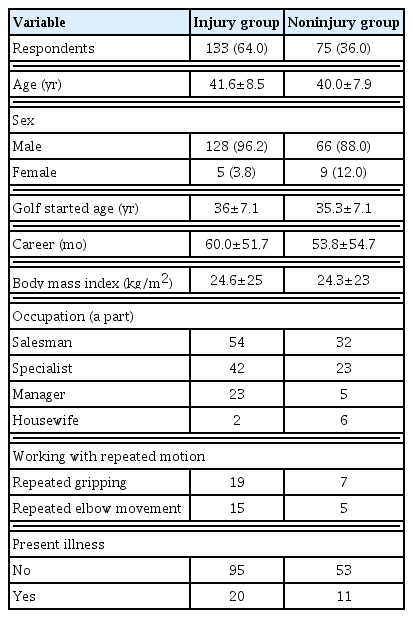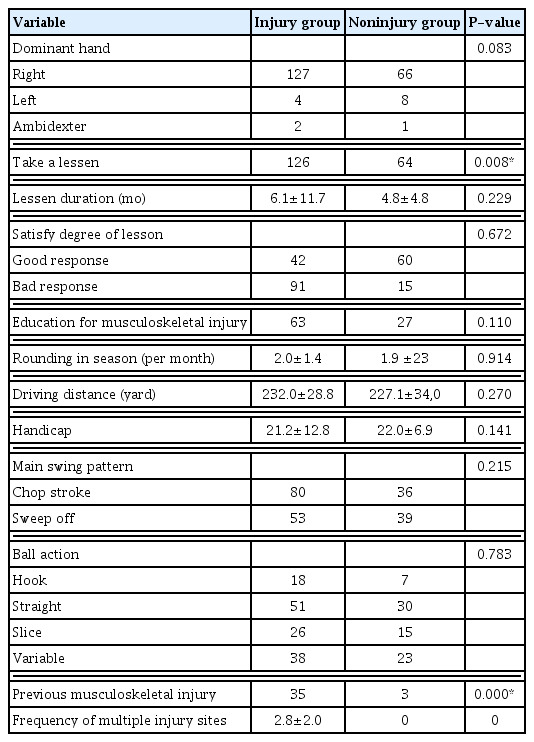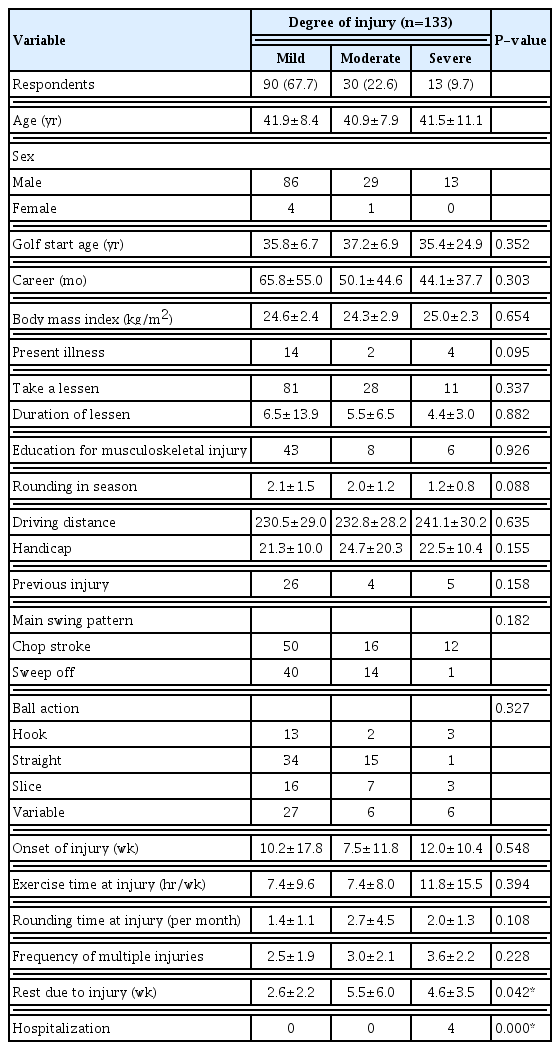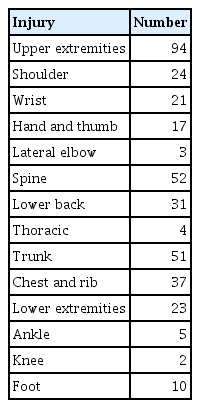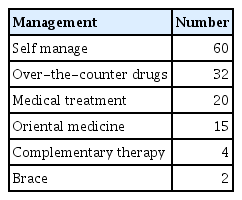Golf-related sports injuries of the musculoskeletal system
Article information
Abstract
The purpose of this study was to evaluate the characteristics of golf-related musculoskeletal injuries. Golfers were retrospectively surveyed through a 50-item questionnaire. Golfers were divided into injured and noninjured groups according to the presence or absence of musculoskeletal injuries. Of the 208 respondents, 64.0% suffered golf-related injuries, most of which were minor injuries caused by overuse in the early 9.9 weeks. According to the anatomical distribution, the most injured parts were upper limbs, spine, trunk, and lower limbs in that order. As for the distribution by part, the hand and wrist were the most vulnerable, and the lateral elbow damage was 3 times more common than the inner elbow. Self-management for injuries was the most common treatment, and regular preventive exercise accounted for 30% of the injured. Overall, more than half of the respondents suffered from musculoskeletal injuries, self-management was the most common, and less than one-third did regular exercise to prevent injuries. Therefore, active management to prevent golf-related musculoskeletal injuries may be necessary.
INTRODUCTION
Recently, golf has become very popular all over the world and is in the limelight as a sport that can be enjoyed by people of all ages. In the case of the United States, it has a golf population of over 96 million, showing a 33% increase between 1996 and 10 years (Werner, 2000). According to the 2020 report by the National Statistical Office, only about 5.1 million people, or 12.1% of Korean adults aged 15 or older, used golf courses at least once, and the number of golf courses was 501, with 46,736,744 people using golf courses. As interest in economic stability and health has grown, interest in golf has also increased, and the golf population is also showing a rapid quantitative increase.
Golf is generally known as a sport with little aerobic effect as a sport without physical contact and is thought of as a sport with little damage, but musculoskeletal damage also occurs in golf (Stockard, 2001). As the golf population increases, golf-related injuries are also increasing. In a study in England, the birthplace of golf, 57% of 163 amateur golfers suffered a golf-related injury during the year (Batt, 1992). The prevalence of general injuries in golf was estimated to be 27.1%, and it tended to be higher in women (32.0%) than men (24.5%). Injuries were predominantly higher in the upper extremities (42.4%), spine (39.7%), and lower extremities (17.9%). The recovery period of injured golfers was less than 1 month in 37.8% and less than 6 months in 69.5%. Technical errors accounted for 53.9% of injuries, followed by overuse (30.8%) and overuse (14.1%) of the trunk during the swing (Thériault et al., 1996).
In a domestic survey, the frequency of recent golf-related pain complaints was reported to be 63.2% (Seo and Kim, 2003). However, despite the rapid growth of golf instruction and high golf injury rates, overuse golf injuries have received little attention (McCarroll, 2001). In particular, the relationship between golf-related factors and the degree of damage has not been studied. There is also medial epicondylitis, traditionally referred to as golfer’s elbow, but in fact, lateral epicondylitis is more common in golfers, so it’s time to think about terminology (McCarroll, 2001; Stockard, 2001). Therefore, this study began to analyze the causes of golf-related musculoskeletal damage and pain in order to be used as basic data for rehabilitation treatment related to golf injuries.
MATERIALS AND METHODS
Subject and method
This study was investigated using a questionnaire consisting of 50 questions. Professional and amateur golfers in Incheon were asked whether they had played golf before the survey, explained the purpose and purpose of the study, and asked them to fill out the questionnaire if they agreed. The contents of the questionnaire consisted of demographic survey, golf-related factors, anatomical parts and causes and treatment of injuries, and types of reinjury prevention exercises. Among the subjects, cases without golf-related injuries were classified as noninjury group, and those who experienced injuries were classified as injured group. The injury group was divided into mild (recovery after 1 to 5 days after injury), moderate (several weeks of treatment after injury), and severe (long-term treatment after injury) injury group according to the degree of damage, and the differences between the three groups were compared and analyzed.
Data analysis
One-way analysis of variance and Duncan post hoc test were used for data analysis. Results were expressed as number (%) or mean± standard deviation. P<0.05 was considered statistically significant.
RESULS
Demographic and sociological characteristics
We included 208 statistically useful subjects. There were 194 men and 14 women. The average age was 40 years old, the average age of starting golf was 35 years old, and the average body mass index was 24.6 kg/m2. The prevalence of musculoskeletal injury due to golf was 64.0% in 133 patients. Respondents’ occupations were salesperson, self-employed, professional, and manager in that order. Comorbidities accounted for 15% each, followed by hypertension (57.9%), diabetes (15.8%), and musculoskeletal disorders (13.2%) (Table 1).
Characteristics of golf-related factors
General characteristics related to golf were investigated according to the subjects’ subjective judgment. Most of the study subjects showed right hand dominance, and 86% took golf lessons for an average of 5.5 months in the early stage, and the satisfaction with the lessons was low in the injury group. The average number of rounds played per month during the regular golf season was 1.95. In terms of main iron swing posture, the injured group showed a chop stroke pattern and the uninjured group showed a slightly more sweep-off pattern. There were significantly more cases of previous musculoskeletal injuries in the injury group (P<0.05). The average frequency of multiple injuries was 2.8 per individual (Table 2).
Characteristics of golf-related factors according to the degree of damage
Golf injuries accounted for 64.0%, with more injuries occurring at the driving range (67.7%) than during the game (7.6%). The degree of damage was mild (67.7%), moderate (22.6%), and severe (9.8%) in order (Table 3).
Distribution and frequency by area of injury and pain
The distribution of injuries and pain areas was in the order of upper limbs, spine, trunk, and lower limbs overall, and lateral elbow joint injuries were approximately 3 times more common than medial elbow joint injuries (Table 4).
Mechanism and treatment of golf injuries
The causes and mechanisms of golf injuries were mainly caused by overuse, incorrect swing posture, and pulling motion with a strong grip in the case of amateurs, and overuse and lack of preparation and clean-up exercises were common in the case of professional golfers (Table 5). For the treatment of golf-related injuries, self-diagnosis and patch use were the most common, followed by drug intake at a pharmacy, hospital treatment, and oriental medicine treatment (Table 6).
Injury pathways and recurrence prevention exercise
Most injuries were first-time, and the most common golf-related pain was back pain and elbow pain). Fitness club, jogging, and running were the most frequent activities to prevent recurrence due to injury (Table 7).
DISCUSSION
Golf is known as a sport with a relatively low risk of physical damage because it does not burden the cardiovascular system, has little physical contact with colleagues, and does not increase musculoskeletal stress. However, golfers’ physical impairment has been underestimated or overlooked (Stockard, 2001; Thériault and Lachance, 1998). Golf-related injuries affect 25%–62% of amateur golfers and 89% of professional golfers (Batt, 1992; McCarroll et al., 1990).
In this study, the injury rate was 64.0%, and the prevalence was similar to the golf-related pain complaint frequency of 63.2% in an Internet survey targeting domestic amateur golfers. Most injuries were significantly more common in men, they took lessons more frequently, and they were more likely to suffer musculoskeletal injuries before starting golf. The period of not playing golf was significantly longer in the group with severe damage (Tables 1–3). McCarroll (1996) reported that injuries were common in the handicap group with low pain. Wrist injuries were more common in the lower handicap group and shoulder injuries were more frequent in the higher handicap group (Batt, 1992; Batt, 1993). However, in this study, there was no difference between the injured group and the uninjured group according to handicap, and there was no difference according to the degree of injury in the injured group (Tables 2, 3).
Back and wrist injuries occur in professional male golfers, whereas female professional golfers are more likely to suffer wrist and back injuries (McCarroll, 1996). Golf injuries are caused by overuse or trauma and primarily affect the elbow, wrist, shoulder, and lumbar spine (Thériault and Lachance, 1998). Golf is not a sport that is known for being prone to injuries, but injuries do happen. These accidents include injuries of the overuse type. Although the incidence of golf injuries differs according to gender and professional or amateur players, the distribution of injuries shows a similar trend (Stockard, 2001). In general, lateral epicondylitis occurred approximately 5 times more frequently than medial epicondylitis (McCarroll, 1996; Stockard, 2001). In this study, lateral epicondylitis occurred 3 times more frequently (Table 4), and the main site of injury was the upper extremity, spine, trunk, and lower limbs, and the hand and arm joints were the most common injuries (Table 4). The left wrist, back, and left hand are most commonly injured in professional golfers (McCarroll and Gioe, 1982). Anatomically, most golf injuries are confined to the back, wrists, elbows, and shoulders (Batt, 1993). It is known that both professional players and amateur golfers often suffer from overuse such as excessive practice or participating in many games, and frequent damage such as hitting the ground to make a divot. Injuries caused by overswing or faulty swing mechanics are very common among amateurs (Batt, 1993; McCarroll et al., 1990). The mechanism of occurrence in this study was the same as in previous studies (Table 5).
Various diseases such as lateral and medial epicondylitis and medial collateral ligament damage and rupture due to chronic repetitive microtrauma are commonly diagnosed in golf injuries. Kohn (1996) emphasized the importance of stretching and warm-up exercises because elbow damage occurs as a compensation exercise when the axis of rotation is distorted during the golf backswing. There is also a risk of injury in golf, and this risk can be reduced by improving skill and fitness levels (Thériault et al., 1996). In this study, most of the self-treatment was carried out rather than professional treatment, and it is common to aggravate secondary damage according to the advice of non-professional acquaintances or consecutive games or practice schedules. Nevertheless, 30% of the injured group performed regular relapse prevention exercises (Tables 6, 7).
Good treatment for the rehabilitation and prevention of back injuries in golf is thought to be through a multidisciplinary approach (Finn, 2013). The prevalence of knee injuries ranged from 3%–18%, the same for both professional and amateur athletes, with no clear dependence on skill level or gender. However, older players appear to be at greater risk of injury (Baker et al., 2017). Although injuries occur in all age groups in golf, the frequency and rate of injuries were higher at both ends of the age spectrum. Given that patients older than 55 have higher rates of injury and hospitalization, this age group deserves special attention in injury prevention efforts (Walsh et al., 2017). Recommendations for return to golf should carefully consider the unilateral nature of the injury (Baker et al., 2017).
This study has a limit to memory by analyzing the questionnaire written from the golfers who agreed to the study as a basic data. It is thought that more precise research related to golf-related damage is needed for various regions and occupational groups in the future.
ACKNOWLEDGMENTS
The authors received no financial support for this article.
Notes
CONFLICT OF INTEREST
No potential conflict of interest relevant to this article was reported.
